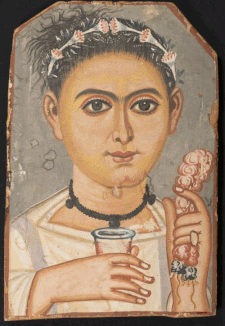Over a year ago, our conservators began examining some of our ancient Egyptian portrait panel painti
Over a year ago, our conservators began examining some of our ancient Egyptian portrait panel paintings as part of the Ancient Panel Paintings: Examination, Analysis and Research (APPEAR) Project. In that time, we have looked at all six portraits in the Brooklyn Museum’s collection, and have begun to better understand the techniques used to create these impressive, life-like portraits. Multiband imaging techniques have provided us with some insight into material responses and characterization, while x-radiography has helped us to visualize preparatory underpaintings.In the images above of Boy with a Floral Garland in his Hair (ca. 200-230CE, reportedly from Er-Rubiyat, Faiyum Region) you can see examples of various imaging techniques. The first image is a visible light photo, followed by an ultraviolet-induced visible fluorescence image which highlights some restoration and colorant use, then a false color infrared photograph which has been generated in Photoshop to characterize particular materials based on their coloration, followed by a composite x-radiograph image, and finally a still from the reflectance transformation imaging set. We have paired these techniques with fiber optics reflectance spectroscopy (FORS) and x-ray fluorescence spectroscopy (XRF) to gain a further understanding of possible material use.There are many different aspects to consider when looking at materials and application techniques. Some of the portraits are encaustic, meaning they were created with a hot wax medium, while others (such as the portait above) are tempera, and were likely created with a paint containing an animal glue binder (analysis is ongoing). Additionally, a variety of different colorants were used on the pieces. To allow us to focus in, we have been looking at the use of indigo on the portraits. More on this in an upcoming entry!Posted by Dawn Kriss -- source link
Tumblr Blog : brooklynmuseum.tumblr.com
#bkmconservation#getty#ancient#egyptian#portrait#paintings#art#art history#science#art conservation#museums#art museums#light#ultraviolet#xray#encaustic#wax#tempera#glue#colorants#highlight

